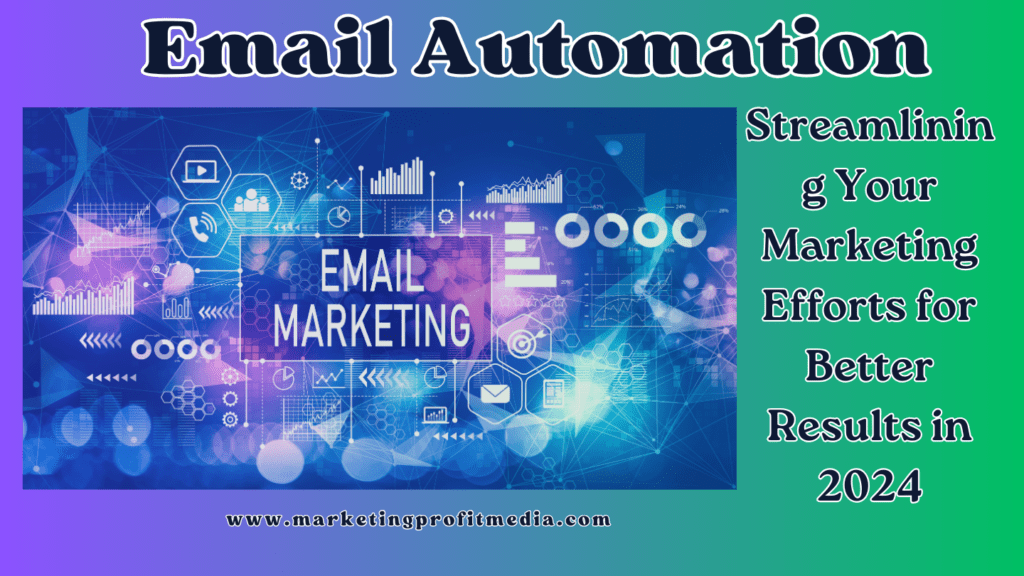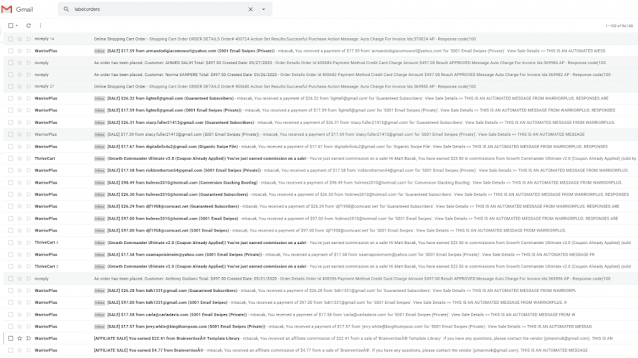Email marketing has always been a cornerstone of digital marketing strategy, and in 2024, its importance is more than ever. As organizations struggle to remain competitive, email automation emerges as a critical component for simplifying marketing efforts and improving outcomes. In this post, we’ll go over the ins and outs of email automation, including its advantages, best practices, and how you can use it to succeed in the changing marketing environment of 2024. In the ever-changing world of digital marketing, being current on the newest trends and technology is critical. Email automation is one of the most useful tools for marketers, and it’s a key part of easily reaching marketing goals. Understanding the importance of email automation in the bigger picture of modern marketing is important before we get into the details of email automation.

My Best Recommended & Proven Way to Make $100 Daily – Watch THIS FREE Training to START >>
Email Automation Overview
Email automation, in simple terms, refers to the use of technology to automate the process of sending emails to a targeted audience. This goes beyond traditional email marketing by allowing businesses to send personalized, timely, and relevant messages to their audience based on predefined triggers or actions.
How Important Email Marketing Is in 2024
Even with the rise of social media and the constant evolution of algorithms, email is still a tried-and-true method of reaching your target demographic. A more personal connection between brands and consumers can only lead to increased engagement and loyalty, and this platform allows for just that.
Email Automation in Streamlining Marketing Efforts
The sheer volume of data and the need for timely responses in today’s marketing landscape make manual email campaigns impractical. Email automation addresses this challenge by streamlining the marketing process, allowing businesses to reach their audience with precision, efficiency, and a personalized touch.

Understanding Email Automation
To harness the power of email automation effectively, it’s crucial to grasp its fundamental components and how they work together seamlessly.
Definition and Purpose
At its core, email automation involves the use of software to send targeted messages to your audience automatically. This could include welcome emails, product recommendations, or follow-up messages based on specific actions or behaviors.
Key Components of Email Automation
1. Triggers and Workflows
Triggers are the events or actions that initiate an automated email. This could be a user signing up for a newsletter, making a purchase, or abandoning a shopping cart. Workflows, on the other hand, are the sequences of automated emails triggered by specific events, guiding users through a predetermined journey.
2. Segmentation
Segmentation involves dividing your audience into groups based on specific criteria such as demographics, behavior, or preferences. This allows for more targeted and relevant email campaigns, increasing the likelihood of engagement.
3. Personalization
Personalization is the key to making your automated emails resonate with your audience. By tailoring content based on individual preferences, purchase history, or interactions, you create a more meaningful connection with your customers.
Benefits of Email Automation
The adoption of email automation brings forth a myriad of advantages for businesses looking to enhance their marketing efforts.
Increased Efficiency
One of the primary benefits of email automation is the significant increase in efficiency. Automation eliminates the need for manual intervention in every step of the email marketing process, allowing marketers to focus on strategy and creativity.
Improved Targeting and Segmentation
Email automation enables businesses to target specific segments of their audience with highly relevant content. This level of customization not only enhances engagement but also contributes to higher conversion rates.
Enhanced Customer Engagement
Personalized and timely communication fosters better engagement with your audience. Email automation allows you to deliver content when your audience is most receptive, increasing the likelihood of interaction and conversion.
Time and Cost Savings
Automating repetitive tasks not only saves time but also reduces operational costs. With email automation, you can achieve more with fewer resources, making it a cost-effective solution for businesses of all sizes.
Choosing the Right Email Automation Tools
Selecting the appropriate email automation tool is a critical decision that can significantly impact the success of your campaigns.
Overview of Popular Email Automation Platforms
The market offers a plethora of email automation platforms, each with its unique features and capabilities. Some of the leading platforms include Mailchimp, HubSpot, and ActiveCampaign.
Factors to Consider When Selecting a Tool
When choosing an email automation tool, factors such as ease of use, integration capabilities, pricing, and customer support should be taken into account. It’s essential to align the features of the chosen platform with your specific business needs.
Case Studies on Successful Implementations
Examining case studies of businesses that have successfully implemented email automation can provide valuable insights. These real-world examples showcase how different industries leverage automation to achieve their marketing goals.
My Best Recommended & Proven Way to Make $100 Daily – Watch THIS FREE Training to START >>
Setting Up Email Automation Campaigns
The success of an email automation campaign hinges on careful planning and execution.
Establishing Campaign Goals
Before diving into the intricacies of email automation, it’s crucial to define clear and measurable goals for your campaigns. Whether it’s increasing sales, boosting engagement, or nurturing leads, having a well-defined objective guides your strategy.
Creating Compelling Content
Compelling content is the backbone of any successful email campaign. Tailor your content to resonate with your audience, addressing their pain points and providing solutions. This not only captures attention but also encourages action.
Designing Effective Email Templates
The visual appeal of your emails is as important as the content itself. Invest time in creating visually appealing and responsive email templates that enhance the user experience across various devices.
A/B Testing for Optimization
A/B testing involves sending variations of your emails to different segments of your audience to determine which performs better. This iterative process helps optimize your campaigns over time, ensuring maximum effectiveness.
Best Practices for Email Automation
To maximize the impact of your email automation efforts, it’s essential to adhere to industry best practices.
Crafting Engaging Subject Lines
The subject line is the first thing your audience sees, and it plays a pivotal role in determining whether your email gets opened. Craft compelling and relevant subject lines that entice recipients to click.
Personalizing Content for Different Segments
Segmentation allows you to tailor content based on the unique characteristics of different audience segments. Leverage personalization to create a sense of exclusivity and relevance for each group.
Monitoring and Analyzing Campaign Performance
Regularly monitor key performance indicators (KPIs) such as open rates, click-through rates, and conversion rates. Analyzing this data provides valuable insights into what works and what needs improvement.
Continuous Improvement Through Feedback Loops
Seek feedback from your audience through surveys or direct communication. Use this feedback loop to iterate and improve your email automation strategy continually.
Overcoming Challenges in Email Automation
While email automation offers numerous benefits, it’s not without its challenges. Understanding and addressing these challenges is crucial for sustained success.
Common Pitfalls to Avoid
From over-automation to neglecting personalization, there are common pitfalls that businesses may encounter. Awareness of these pitfalls is the first step in avoiding them and ensuring a positive user experience.
Addressing Deliverability Issues
Email deliverability is a critical aspect of any email marketing strategy. Take steps to maintain a good sender reputation, avoid spam triggers, and ensure your emails reach the intended recipients.
Staying Compliant With Regulations
As data privacy regulations evolve, staying compliant is non-negotiable. Familiarize yourself with laws such as GDPR and CAN-SPAM and ensure your email practices align with these regulations.
Integration with Other Marketing Channels
For a holistic marketing approach, email automation should be seamlessly integrated with other channels.
Synergies With Social Media and Content Marketing
Coordinate your email automation efforts with social media and content marketing strategies. This synergy creates a cohesive brand presence across multiple platforms, reinforcing your message.
Building a Cohesive Multichannel Marketing Strategy
A multichannel marketing strategy ensures that your brand remains visible and relevant across various touchpoints. Integrating email automation into this strategy enhances the overall effectiveness of your marketing efforts.
Trends in Email Automation for 2024
As technology continues to advance, so do the trends in email automation.
AI and Machine Learning Advancements
The integration of artificial intelligence (AI) and machine learning (ML) in email automation allows for more sophisticated personalization and predictive analytics. Smart algorithms can analyze user behavior to anticipate preferences and optimize content delivery.
Interactive and Dynamic Content
Static emails are becoming a thing of the past. Interactive and dynamic content keeps recipients engaged, allowing them to interact with your brand directly within the email. This includes elements such as polls, quizzes, and product carousels.
Integrating User-Generated Content
User-generated content adds authenticity to your emails. Encourage your audience to share their experiences and showcase this content in your campaigns. This not only builds trust but also creates a sense of community around your brand.
My Best Recommended & Proven Way to Make $100 Daily – Watch THIS FREE Training to START >>
Case Studies: Successful Email Automation Campaigns
Real-world examples provide insights into the practical application of email automation strategies.
Boosting Sales Through Personalization
In this case study, demonstrates how personalized email automation significantly increased sales. By segmenting their audience based on previous purchases and preferences, they delivered targeted product recommendations that resonated with individual customers.
Nurturing Leads with Drip Campaigns
Showcases the power of drip campaigns in nurturing leads through the sales funnel. By strategically sending a series of automated emails, they guided prospects from initial awareness to conversion, resulting in a higher conversion rate.
Future Outlook for Email Automation
As we look ahead, the future of email automation holds exciting possibilities.
Evolving Technologies and Their Impact
Advancements in technology, including AI, blockchain, and augmented reality, are poised to reshape the landscape of email automation. Businesses that embrace these technologies will have a competitive edge in delivering innovative and personalized experiences.
Predictions for the Role of Email Automation in 2025
Experts predict that email automation will continue to play a pivotal role in marketing strategies. The focus will shift towards even more advanced personalization, hyper-targeting, and integration with emerging technologies.
Conclusion
In conclusion, email automation stands as a cornerstone in the realm of modern marketing. Its ability to streamline processes, enhance targeting, and foster meaningful engagement positions it as a vital tool for businesses seeking success in 2024 and beyond. As you embark on your email automation journey, remember to stay informed, embrace best practices, and adapt to the evolving landscape.
FAQs
Q. What is the difference between email marketing and email automation?
Email marketing involves sending emails to a list of subscribers, whereas email automation uses technology to send targeted and personalized messages automatically based on predefined triggers or actions.
Q. Can small businesses benefit from email automation?
Absolutely. Email automation is scalable and can be tailored to suit the needs and size of any business. It allows small businesses to engage with their audience efficiently and compete on a level playing field.
Q. How often should I review and update my automated email campaigns?
Regularly reviewing and updating your automated email campaigns is essential. Aim for quarterly reviews to assess performance, update content, and ensure alignment with your business goals.
Q. Are there any risks associated with relying heavily on email automation?
Over-reliance on automation without proper monitoring and adjustments can lead to generic and impersonal communication. It’s crucial to find the right balance and continuously refine your strategy for optimal results.
Q. What metrics should I track to measure the success of my email automation campaigns?
Key metrics to track include open rates, click-through rates, conversion rates, and the overall engagement of your audience. Analyzing these metrics provides insights into the effectiveness of your campaigns and areas for improvement.
My Best Recommended & Proven Way to Make $100 Daily – Watch THIS FREE Training to START >>
Thanks for reading my article on “Email Automation – Streamlining Your Marketing Efforts for Better Results in 2024“, hope it will help!














